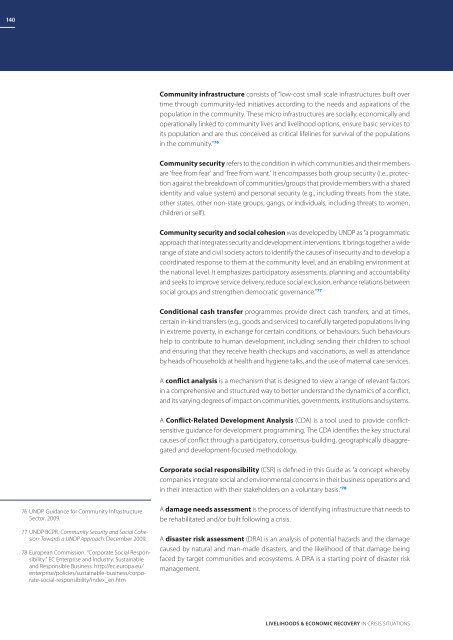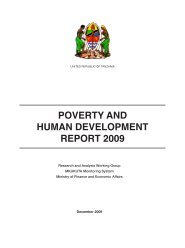Download PDF (4.08 MB) - ReliefWeb
Download PDF (4.08 MB) - ReliefWeb
Download PDF (4.08 MB) - ReliefWeb
You also want an ePaper? Increase the reach of your titles
YUMPU automatically turns print PDFs into web optimized ePapers that Google loves.
140<br />
Community infrastructure consists of “low-cost small scale infrastructures built over<br />
time through community-led initiatives according to the needs and aspirations of the<br />
population in the community. These micro infrastructures are socially, economically and<br />
operationally linked to community lives and livelihood options, ensure basic services to<br />
its population and are thus conceived as critical lifelines for survival of the populations<br />
in the community.” 76<br />
Community security refers to the condition in which communities and their members<br />
are ‘free from fear’ and ‘free from want.’ It encompasses both group security (i.e., protection<br />
against the breakdown of communities/groups that provide members with a shared<br />
identity and value system) and personal security (e.g., including threats from the state,<br />
other states, other non-state groups, gangs, or individuals, including threats to women,<br />
children or self).<br />
Community security and social cohesion was developed by UNDP as “a programmatic<br />
approach that integrates security and development interventions. It brings together a wide<br />
range of state and civil society actors to identify the causes of insecurity and to develop a<br />
coordinated response to them at the community level, and an enabling environment at<br />
the national level. It emphasizes participatory assessments, planning and accountability<br />
and seeks to improve service delivery, reduce social exclusion, enhance relations between<br />
social groups and strengthen democratic governance.” 77<br />
Conditional cash transfer programmes provide direct cash transfers, and at times,<br />
certain in-kind transfers (e.g., goods and services) to carefully targeted populations living<br />
in extreme poverty, in exchange for certain conditions, or behaviours. Such behaviours<br />
help to contribute to human development, including: sending their children to school<br />
and ensuring that they receive health checkups and vaccinations, as well as attendance<br />
by heads of households at health and hygiene talks, and the use of maternal care services.<br />
A conflict analysis is a mechanism that is designed to view a range of relevant factors<br />
in a comprehensive and structured way to better understand the dynamics of a conflict,<br />
and its varying degrees of impact on communities, governments, institutions and systems.<br />
A Conflict-Related Development Analysis (CDA) is a tool used to provide conflictsensitive<br />
guidance for development programming. The CDA identifies the key structural<br />
causes of conflict through a participatory, consensus-building, geographically disaggregated<br />
and development-focused methodology.<br />
Corporate social responsibility (CSR) is defined in this Guide as “a concept whereby<br />
companies integrate social and environmental concerns in their business operations and<br />
in their interaction with their stakeholders on a voluntary basis.” 78<br />
76 UNDP. Guidance for Community Infrastructure<br />
Sector. 2009.<br />
77 UNDP BCPR. Community Security and Social Cohesion:<br />
Towards a UNDP Approach. December 2009.<br />
78 European Commission. “Corporate Social Responsibility.”<br />
EC Enterprise and Industry: Sustainable<br />
and Responsible Business. http://ec.europa.eu/<br />
enterprise/policies/sustainable-business/corporate-social-responsibility/index_en.htm<br />
A damage needs assessment is the process of identifying infrastructure that needs to<br />
be rehabilitated and/or built following a crisis.<br />
A disaster risk assessment (DRA) is an analysis of potential hazards and the damage<br />
caused by natural and man-made disasters, and the likelihood of that damage being<br />
faced by target communities and ecosystems. A DRA is a starting point of disaster risk<br />
management.<br />
Livelihoods & Economic Recovery in Crisis Situations





